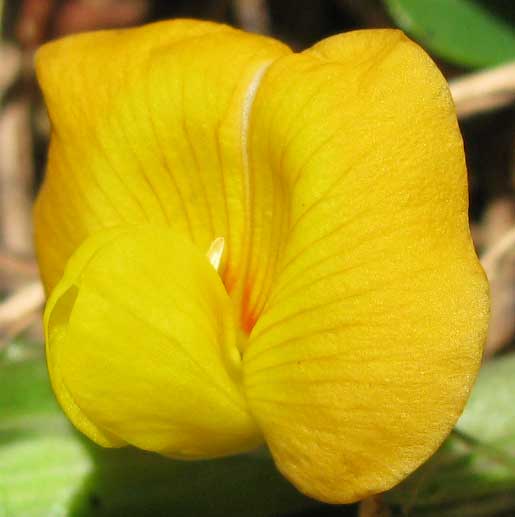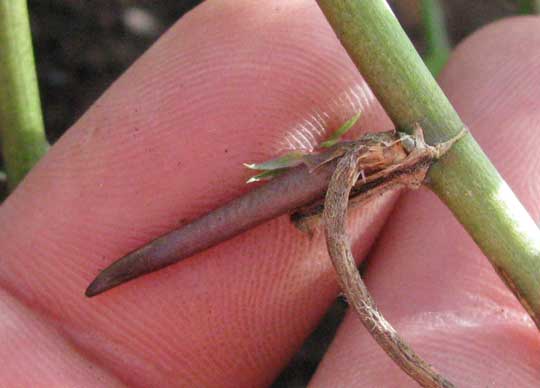Excerpts from Jim Conrad's
Naturalist Newsletter

from the February 6, 2011 Newsletter issued from Hacienda Chichen Resort beside Chichén Itzá Ruins, central Yucatán, MÉXICO; limestone bedrock, elevation ~39m (~128ft), ~N20.676°, ~W88.569°
HOW DO PEANUTS GET UNDERGROUND?
Before Wilfrido the milpa man left for a job elsewhere he planted some peanuts. Now the plants are up and flowering, and when one passes them it's hard to escape the question, "If the plants have flowers on their branches, and peanuts with their shells are regarded as actual fruits, or legumes (and they are), then how do peanut legumes get underground?" Wilfrido's plants show us.
First, take a look at the pinnately compound leaves, broadly based green stipules at the petioles' bases, and a small, yellow flower in the crook of my index finger of a Peanut plant, ARACHIS HYPOGAEA, at the top of this page.
Peanut plants are members of the Bean Family and have papilionaceous flowers, as seen below:

Since the unit comprising the Peanut's shell with its two or three "nuts" inside is actually a legume-fruit with the "nuts" being beans, or seeds, the shell with its contents began as an ovary in a self-pollinated flower such as the one above.
But such flowers wither quickly, leaving only their stalks, or pedicels, and at the tip of each pedicel an ovary. The purplish pedicel quickly begins enlarging and elongating. You can see such a pedicle below:

In that picture, the slender stem curling into the lower right corner is an old pedicle that shriveled and died for lack of water. The new pedicle is the purple, sharp-pointed thing atop my fingertip. Eventually this pedicle will reach the ground and burrow into it, driving the ovary before it. But, in the picture, where is the ovary?
With a razor I made a longitudinal section of the pedicle, cutting right through the tip, and I saw nothing looking like ovules or anything to do with an ovary. Therefore, I just have to take the expert's word when he or she writes, "After fertilization, the flower stalk of the peanut curves downward, and the developing pod is forced into the ground by the proliferation and elongation of cells under the ovary."
It's amazing that such a common plant as the Peanut behaves so outlandishly. In fact, its genetic history as outlined on its Wikipedia page also sounds a bit unusual. There it's stated that the Peanut plant is...
"... an amphidiploid or allotetraploid, meaning that it has two sets of chromosomes from two different species, thought to be A. duranensis and A. ipaensis. These likely combined in the wild to form the tetraploid species A. monticola, which gave rise to the domesticated peanut. This domestication might have taken place in Paraguay or Bolivia, where the wildest strains grow today."
In the 1530s when Spanish conquistadores entered Montezuma's capital city Tenochtitlan, known today as Mexico City, peanuts were being offered in the metropolis's vast, well provisioned marketplace. Since the plant is thought to have originated in the Peruvian Andes, there must be a good story about how peanuts got from the Andes to here.